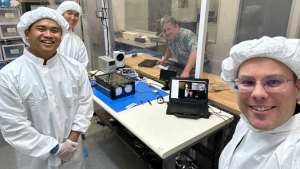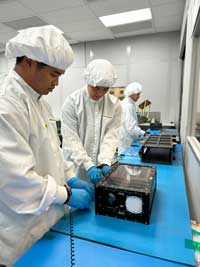
In an unprecedented opportunity for hands-on involvement in space exploration, a team of students and faculty from the University of Hawaiʻi at Mānoa are eagerly anticipating the launch of the Hyperspectral Thermal Imager (HyTI) satellite. Members of the team are preparing to travel to Kennedy Space Center in Florida to witness the launch firsthand on March 14.

Students and researchers work on the HyTI satellite.
“This project has been a highly collaborative effort since its inception,” said Wright. “Many University of Hawaiʻi at Mānoa students, staff and faculty have been involved in the design, integration, and testing of the satellite. We are thrilled to watch the HyTI satellite launch into space and begin the next phase of processing high-resolution thermal images.”
“Being a part of the development for the HyTI satellite with HSFL (Hawaiʻi Space Flight Laboratory) was truly a wonderful opportunity that allowed me to be a part of something so tremendous; that is, building a satellite!” said second-year mechanical engineering student Kent Miyahara.
The HyTI satellite, equipped with onboard data processing capabilities, will deliver high-resolution thermal images, surpassing the capabilities of current sensors. These images will enable scientists and disaster response managers to analyze and respond to environmental events with precision and speed.
“HyTI is the first NASA mission made in Hawaiʻi and possibly one of the most advanced 6U CubeSats in the world,” said Miguel Nunes, deputy principal investigator and systems engineer for the HyTI Mission.
The HyTI satellite, officially owned by NASA and operated by the HSFL, was selected in 2019 as part of NASA’s CubeSat Launch Initiative, under the Educational Launch of Nanosatellites program. Scheduled to launch aboard the SpX-30 Dragon CRS-2 commercial resupply mission to the International Space Station (ISS), deployment from the ISS is expected in May. The mission duration is estimated to be one year.
Real-world student experience

UH students, staff and faculty have been actively involved in the development of the HyTI satellite, including six faculty members, 15 staff, eight graduate students, two post-docs, 30 undergraduate students and six high school interns.
“The mere fact that I have been a part of building a satellite that will be orbiting the Earth in the near future, aimed down at us from many, many miles above, furthering the scientific understanding of Hawaiʻi is absolutely mind blowing and amazing,” Miyahara said.
“It was super cool and exciting to work on something that pushed the boundaries of what’s possible with cutting edge technology to help solve problems of today,” mechanical engineering senior Kenny Son said.
“One of the highlights of my experience working on HyTI was utilizing theory from my classes to contribute to the development of a physical product destined for space,” said third year electrical engineering student Jhon Leo Gabion.
“This has been an incredible opportunity for students, and training our local aerospace workforce, by providing real-world experience working with professional engineers on a NASA mission with real requirements and hardware,” said Yosef Ben Gershom, operations manager at HSFL.

